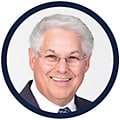Two from-the-field case studies on identifying task-specific low vision solutions.

Low vision eye care is very task specific. It’s truly about functioning, not restoring vision.
As Richard Shuldiner, O.D., FAAO, explains on the subject, “We design low vision glasses and devices according to the task requirements for acuity, working distance, visual field, illumination, and other factors.”

In addition to his practice in Riverside, CA, Dr. Shuldiner is president of the International Academy of Low Vision Specialists (IALVS.org), whose members include 48 low vision optometrists from the United States, Canada, Mexico, and South Africa.
Here he shares two case studies to illustrate low vision solutions that helped get patients back to the daily tasks they enjoy.
CASE 1:
Up for the Task
Mr. J. T., age 95, wanted help for reading and watching TV from about 8 feet away. As a retired banker, he enjoyed following the financials in the newspaper. He has a live-in caregiver to help with daily living.
“At near,” explains Dr. Shuldiner, “he could manage 3.2m at 10 inches (1m is newsprint size). His best distance acuity with his current low myopic and astigmatic correction was OD: 5/30 (20/120) and OS 5/60 (20/240).
“With a 2.5x clear image doublet microscope (10 diopters) eyeglass lens for the right eye, he was able to read newsprint very slowly,” shares Dr. Shuldiner. “The fellow eye was occluded.”
He had not read in quite a while so his lack of fluency was expected. Dr. Shuldiner’s rule of thumb is one week of practice reading for every month someone has not read.
“Mr. J. T. was instructed to read at least five times per day for five minutes at a time to build up his reading speed,” says Dr. Shuldiner. “It was suggested he not be concerned about comprehension at this point, as most of his energy would be spent identifying each word. For improvement in watching TV, he was excited looking through 1.7 full-diameter telescopic glasses focused for his 8-feet distance.
“The two pairs allowed him to perform the tasks he desired,” concludes Dr. Shuldiner.
CASE 2:
On the Menu
Age 93, Ms. Joyce C.’s vision loss was preventing her from reading menus and recipes and recognizing faces. “She lives alone in a retirement village,” explains Dr. Shuldiner, “and her best acuities with her low hyperopic astigmatic correction with +3.50 add were OD 5/25- (20/110) and OS 5/30 (20/120). At near, her acuity was .8m at 13 inches, but with a very small island of good acuity.”
The patient brought several near materials she desperately wanted to read to the appointment. “We found that with strong illumination, she could read the menus of the facility restaurant with her own correction. She couldn’t read smaller-print financials and insurance documents without the help of magnification. After demonstration of various aids,” adds Dr. Shuldiner, “she chose 1.7x telemicroscope readers.
“Due to multiple scotomas and reduced contrast sensitivity, electronic magnification (a CCTV) was suggested. She would be able to read some of her materials with the telescopic readers and smaller-font materials with the CCTV. We also ordered a gooseneck lamp for illumination.”
These cases underscore what can be done for most low vision patients. It’s not about restoring vision. It’s all about helping patients accomplish tasks that are the most important to them.



